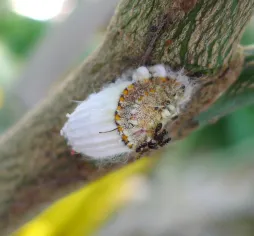Aechmea fasciata, the silver vase
Underneath its tough exterior, Aechmea fasciata is a fragile little thing. This plant, native to Brazil, belongs to the Bromeliaceae family. Like other species in the genus, it dies after flowering.
How to recognize the silver vase, Aechmea fasciata?
Aechmea fasciata is an epiphytic perennial. At 80 cm in height and 60 cm in spread, it has a flared habit.
The silver vase is aculeate. Its thorn-edged leaves grow in a rosette and form a tube. Long, flat and leathery, they resemble ribbons. The gray-green blades are striped with silver. These patterns are the work of trichomes, gray hairs that capture water from the atmosphere. They become transparent when gorged with liquid, and the foliage then turns completely green for a few moments.
After three or four years, Aechmea fasciata flowers. A pyramidal spike adorned with pink bracts rises from the heart of the rosette. Small violet flowers are borne here. They last just one day, but are renewed for over six months. When flowering is over, the plant produces shoots at its base and dies.
Easy to grow, Aechmea fasciata has given rise to numerous cultivars such as aechmea 'Pepita Elegant Flames, with its red bracts, aechmea 'Primera', with its thornless leaves, and Aechmea Blue Rain, with its pink inflorescence.
The silver vase is not a toxic plant. Its foliage and flowers are harmless to humans and animals. Just be careful not to prick yourself with the thorns when handling your Aechmea fasciata.
Our maintenance tips
Aechmea fasciata are often sold already in flower. If you're growing offshoots, be patient! It takes three or four years for the plant to flower.
Watering
Always water your aechmea fasciata with fresh water at room temperature. Preferably use rainwater.
When watering, pour the water into the heart of the plant, into the reservoir formed by the leaves. Water regularly, but not heavily. Keep the soil moist in summer, but allow the surface to dry out in winter.
Aechmea fasciata like to keep two to three centimetres of water at the heart of the rosette. But don't let the water stagnate too long. Before watering, drain off any residual water by tilting the plant slightly.
Spray
Aechmea fasciata like humidity. Mist their foliage with non-calcareous water at room temperature.
Spray the substrate if it is dry.
Repotting
In spring, transfer your Aechmea fasciata to a larger pot, so that it can continue to grow.
Choose a pierced pot twelve to fifteen centimetres in diameter. Line the bottom with a bed of clay balls for drainage.
Then add an aerated substrate. You can buy potting soil for bromeliads or mix orchid potting soil, perlite and coconut fibre. Plant aechmea fasciata in the center, without burying it too deeply.
To maintain a high level of humidity, place the pot on a dish filled with moist clay balls.
Fertilization
You can stimulate the development of your plant during its growth phase, in spring and summer, with fertilizer.
Apply liquid fertilizer for green plants when watering.
Cleaning
It is not advisable to clean the foliage. Leaves are covered with trichomes, small transparent hairs that capture moisture. They are fragile and can be damaged by dusting.
If your plant gets dusty, it's best to baste the foliage with lukewarm water.
Cutting
Wait until the end of flowering to propagate your Silver vase.
Wait until the shoots are at least eight centimetres high before taking them. The taller they are, the more likely they are to survive.
Use a clean knife to separate the shoots. Cut as close as possible to the mother plant. Then dig up your cutting.
Aechmea fasciata are epiphytic plants. They use their roots to anchor themselves in their support, not to feed. So don't worry if your cutting has few or no roots.
Prepare a pierced pot adapted to the size of your cutting. Aechmea fasciata like to be cramped. The container doesn't have to be large (eight centimetres in diameter is enough), but it should be deep enough to support the weight of the plant without tipping over.
Place a layer of clay balls at the bottom for drainage. Then add a potting soil for bromeliads. You can also make your own substrate by mixing orchid potting soil and green plant compost.
Plant your seedling in the center of the pot. Don' t bury it too deeply. Pack lightly and water with non-calcareous water to moisten the soil.
Cuttings sometimes have trouble standing up straight on their own. You can stake the plant to support it.
Disease / Threat
Information
| Family | Bromeliads - Bromeliaceae |
| Type | Aechmea - Aechmea |
| Species | Silver vase - Aechmea fasciata |
| Lifecycle | Perennial |
| Foliage | Evergreen |
| Exposure | |
| Substrat | |
| Planting method |
In pots |
| Categories | |
| Tags |
Beginner Flowery |
| Origin |
South America |
| Hardiness (USDA) | 11a |
| Leaf color |
|
| Flower colors |
|
Discover plants from the same family
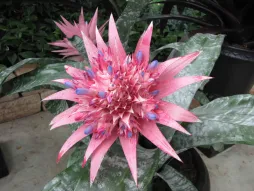
Aechmea Primera
Discover
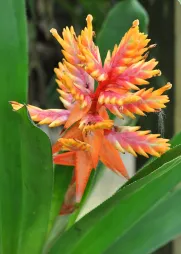
Aechmea 'Pepita Elegant Flames'
Discover
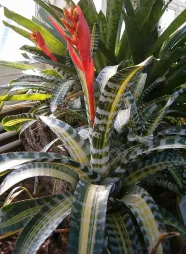
Aechmea chantinii
Discover
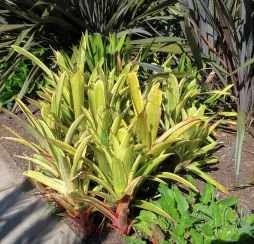
Aechmea caudata
Discover












